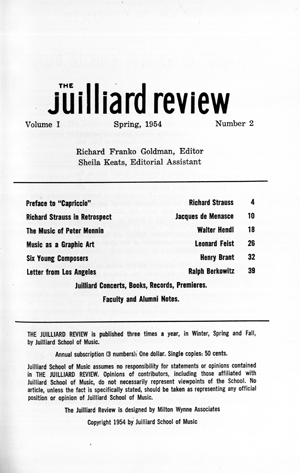The Juilliard Review
Prepared by Liesbeth Hoedemaeker
Online only (2007)

The Juilliard Review1 [JRE] was published three times a year2 in New York by The Juilliard School of Music from January 1954 to fall 1962.3 The JRE intended to offer
a serious view of music in our day, as we find it and in terms of the idea that music is a high art, neither trade, nor entertainment, nor commodity. For an institution such as The Juilliard School of Music education will be necessarily involved.4
Primarily the house organ of the School, it deals with news and topics of interest for its music students and faculty, while at the same time (and especially during the first years of its run), many articles of general musical interest “enlisting the interest of the cultivated musician.”5 The journal also contains illustrations (mostly photographs) which increase in number over the years.
Richard Franko Goldman (1910-1980) was JRE’s editor from January 1954 to spring 1958 and from fall 1958 until spring 1960, as well as one of the fourteen faculty members of the journal’s Editorial Board. A composer, conductor of the Goldman Band, Juilliard faculty member from 1947-1960, Goldman was also a regular contributor to the Musical Quarterly and Executive Director of the League of Composers. His publications include The Concert Band (New York, 1946); The Wind Band: Its Literature and Technique (Boston, 1961); Harmony in Western Music (New York, 1965). For the JRE he wrote five book reviews, two editorials and two articles (about Percy Grainger and the Copland festival).
Sheila Keats, administrative assistant of R. F. Goldman and later piano accompanist and teacher at Juilliard, was JRE’s editorial assistant from January 1954-spring 1957. She was Assistant Editor from fall 1957 to spring 1958, Managing Editor from fall 1958 until spring 1961 and in fall 1961 became Consulting Editor. For the JRE Sheila Keats compiled “American Music on LP Records, an Index” and “Reference Articles on American Composers, an Index.”
Dr. Gideon Waldrop (1919-2000), composer, conductor, professor, and Juilliard Dean in 1963, became the new editor of JRE in fall 1961. Previously, in 1952 and 1953 he served as editor of The Review of Recorded Music and from 1953 to 1958 as editor and general manager of The Musical Courier. He did not contribute to JRE with signed articles or reviews.
The first two volumes contained an average of 64 pages. Beginning with Vol. III, no. 1, an Alumni Supplement to the JRE was also published, with each issue offering information about faculty members, students and alumni. Previously such information had appeared in the journal itself. In total eight supplements appeared, each containing 16 to 25 pages. With the appearance of the supplements the regular issues decreased in size to an average of 50 pages. When the publication of supplements ceased (from Vol. V, no. 3), until the final issue Vol. IX, no. 2, each issue consisted of 32 pages.
The journal of course focuses attention on the institution and related activities with articles, for example, treating the building of the new School at Lincoln Center, and festivals at Juilliard (the Copland Festival, the American Music Festival, the Festival of British Music), performances, prizes, pertinent publications and faculty members. However, there are also a number of articles treating contemporary composers (including Edgard Varèse, Karlheinz Stockhausen, Vincent Persichetti, Percy Grainger, William Bergsma, Henry Brant, Vittorio Giannini and Igor Stravinsky), American music (“American Piano Music” by Josef Bloch; “Aaron Copland’s Piano Fantasy” by Arthur Berger; “Musical Education in America” by William Schuman), and ballet (“Composing a Dance” by José Limon; “Composing for the Dance” by Norman Lloyd, “Advice to Young Choreographers” by Doris Humphrey, and “Dance Notation” by Ann Hutchinson). Also of interest is an article entitled “Rubin Goldmark: a Tribute” by Aaron Copland, “An Unknown Letter by Beethoven” by Nathan Broder, “The Labyrinth of Chopin Ornamentation” by Jan Holcman and the articles by Otto Leuning and Vladimir Ussachevsky dealing with electronic music.
The columns “Faculty Activities” and “Alumni Notes” appear in every issue and contain information concerning many hundreds of individuals related to the School. Among these are the piano teachers Rosina Lhevinne, Carl Friedberg, Lonny Epstein and Irwin Freundlich; violin teachers; Josef Raieff, Edouard Dethier and Louis Persinger; dance teachers Doris Humphrey and José Limòn. Among the students are Van Cliburn; Richard Rodgers and Leontyne Price. Other returning columns are “News of the school” and “The bookshelf” (book reviews). The journal also publishes the Juilliard Orchestra concert programs, commencement addresses, and advertisements.
Among the contributors are William Schuman—composer and president of the School from 1948-1962—Jacques Barzun, Aaron Copland, Henry Cowell, Lukas Foss, Gian Francesco Malipiero, Jean Morel, Richard Strauss, and Virgil Thomson.
This RIPM publication is based on a copy of The Juilliard Review provided by the library of the Juilliard School of Music.
1Available online at: https://juilliard.resourcespace.com/pages/search.php?search=%22juilliard+review%22&order_by=relevance&archive=&k=&restypes=5&sort=ASC [Link updated 10 April 2023]
2January, May and November.
3In 1962 JRE became The Juilliard News Bulletin, in 1984 The Juilliard Bulletin and in 1987 The Juilliard Journal. The latter is available online from September 2007, vol. 23, no. 1 to May-August 2017, vol. 32, no. 8 at https://www.juilliard.edu/school/news/juilliard-journal [Link and scope note updated 10 April 2023].
4 R. F. Goldman, JRE I:1 (1954): 3-6
5William Schuman, “To the Alumni: A Message of William Schuman.” JRE I:1 (1954): 46-47.
